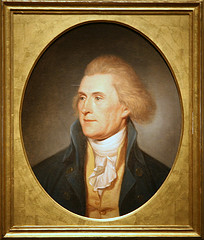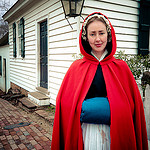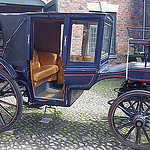Posted by Roberta Grimes • January 04, 2014 • 1 Comment
Ask the Author, Letters From Love Series, Thomas Jefferson
 I came across Alf J. Mapp Jr.’s Thomas Jefferson – A Strange Case of Mistaken Identity in a bookstore one day in 1988, and I was taken with the title. My law practice was in hiatus because my housekeeper had been arrested for drunken driving with my young son in the back seat of her car, and I was looking for something substantial to read. I loved the book, and I fell in love with the earnest young man who was its subject, so I wrote Dr. Mapp my first-ever fan letter. Soon we were phone friends. It was obvious from the book that my new hero had been desperately in love with his wife, but Dr. Mapp told me that since Thomas Jefferson had burned all their letters and all her papers, nobody knew anything about Martha. I told him idly that – what the heck – I was going to figure her out and re-create her journal. My Virginia gentleman friend graciously urged me to do that. I remember saying as we talked about it, “But I don’t know anything about colonial Virginia! I can’t even describe how someone would walk into a room.” He told me that gave me an interesting challenge. And so it did.
I came across Alf J. Mapp Jr.’s Thomas Jefferson – A Strange Case of Mistaken Identity in a bookstore one day in 1988, and I was taken with the title. My law practice was in hiatus because my housekeeper had been arrested for drunken driving with my young son in the back seat of her car, and I was looking for something substantial to read. I loved the book, and I fell in love with the earnest young man who was its subject, so I wrote Dr. Mapp my first-ever fan letter. Soon we were phone friends. It was obvious from the book that my new hero had been desperately in love with his wife, but Dr. Mapp told me that since Thomas Jefferson had burned all their letters and all her papers, nobody knew anything about Martha. I told him idly that – what the heck – I was going to figure her out and re-create her journal. My Virginia gentleman friend graciously urged me to do that. I remember saying as we talked about it, “But I don’t know anything about colonial Virginia! I can’t even describe how someone would walk into a room.” He told me that gave me an interesting challenge. And so it did.
I wrote My Thomas more than twenty years ago, but I remember the process vividly. I wanted first to see where Thomas and Martha had lived, so we took a family vacation to Williamsburg and began the drive up to Monticello. We were derailed by an auto accident in Richmond. Not deterred, I soon spent a week in Charlottesville and had a private tour of Monticello as if I were an actual scholar, and for day after day I sat and transcribed Thomas Jefferson’s letters and papers and account books. I had to do it in longhand. They would allow neither the photocopying of original documents nor the use of a typewriter in their quiet library, and this was long before laptop computers. The ipad was not yet a gleam in Steve Jobs’s eye.
Spending a week reading Thomas Jefferson’s handwriting in the actual ink in which he placed it on the page, seeing his patient notations of what he had been doing, what he had spent, what he owed to which slave, and what he had been thinking was an unforgettable experience for me. Being surrounded by extraordinarily warm and gracious Virginians who spoke with an accent that was probably a lot like his own made me feel still closer to the man.
Nobody at Monticello knew much about Martha, but I was told that she had died of tuberculosis. Someone had written a definitive paper. I waited to read that paper until I had transcribed my whole thirteen years of Jefferson’s life with Martha, then I asked to see the paper that proved that Martha had died of tuberculosis. What I was given was an exhaustive study of Jefferson’s illnesses and treatments throughout his life. As I recall, the last sentence of it was, “And as for Martha, what could she have died of but tuberculosis?” That pretty well sums up the attitude of historians toward Martha Jefferson. We can’t know much, so we have to assume that she didn’t matter much.
By the time I came home from Monticello, I knew that I really was going to attempt to re-create Martha Jefferson’s journal. I thought she deserved to have someone try to know her well enough to bring her back to life, especially since I was seeing at that point how essential she had been to her young husband’s development. They had lived in an age when women often died in childbirth and many men buried two or three wives, but Thomas Jefferson had mourned his Martha forever. That had to have been one remarkable lady!
We forget now how difficult it was to do research before the advent of the Internet. I went to libraries, I bought books, I steeped myself in 1770s Virginia life. With only a dozen years to cover, I was able to focus my research to the point that eventually I could describe precisely how someone would have entered a room. The odd juxtaposition of aristocratic formality with gritty farm life surprised me. So many things surprised me! Readers of My Thomas have insisted that I must have made up the part about the Jeffersons buying food from their slaves, but the accounts still survive in Thomas’s own hand. I plan eventually to do a series of posts on Martha’s diabetes, on slavery in colonial Virginia, on the Sally Hemings question, and perhaps on other aspects of the novel, so if there is a question that interests you, I hope that you will let me know.
It’s impossible to look at Martha directly, just as scientists can’t look at a black hole directly. Black holes deform the light of the stars around them, though, and scientists study them largely by studying these effects. In the same way, studying how she seemed to affect Thomas’s light is a useful way to come to know Martha Jefferson.
 And we can seek to understand what the ideal woman would have been for a man like the young Thomas Jefferson. He was rather shy, earnest, bookish, high-minded, and ambitious. He seems to have been someone whose company gentlemen enjoyed, someone they admired and marked for success, but ladies seem to have found him clumsy. It has been suggested in recent years that Thomas Jefferson was a high-functioning Asperger’s Syndrome person. I have Asperger’s in my family, and I have to say that diagnosis seems right, although at the time that I wrote the novel I had never heard the term.
And we can seek to understand what the ideal woman would have been for a man like the young Thomas Jefferson. He was rather shy, earnest, bookish, high-minded, and ambitious. He seems to have been someone whose company gentlemen enjoyed, someone they admired and marked for success, but ladies seem to have found him clumsy. It has been suggested in recent years that Thomas Jefferson was a high-functioning Asperger’s Syndrome person. I have Asperger’s in my family, and I have to say that diagnosis seems right, although at the time that I wrote the novel I had never heard the term.
So this was my strategy. Discover as closely as you can the shape of the hole, precisely carve the plug to fit it, and you have a woman who so completed the man that when she died so young he never found love again. He spent more than forty years mourning her loss.
The proof in this for me was that when I put together the Thomas I had come to know and the Martha I had managed to fashion, they immediately began to write their own story. It was amazing and wonderful to watch. I had to keep them to the plot that history had dictated, so I was meticulously researching and double-checking and setting up their scenes. But then I would say, “Okay, you’re on!” and sit back and watch and listen. My Thomas and his Martha did every scene in one take.
And they grew as characters in ways that didn’t have anything to do with me. That Martha became an ardent abolitionist and champion of human rights was nothing I had intended, but it shouldn’t be surprising when  her beloved surrogate stepmother and several half-siblings were slaves. I watched them develop as abolitionists together, Thomas Jefferson and his Martha, to the point where toward the end of her life he was plotting his checkerboard experiment to see whether blacks and whites could live together… and that experiment comes from his contemporary writings.
her beloved surrogate stepmother and several half-siblings were slaves. I watched them develop as abolitionists together, Thomas Jefferson and his Martha, to the point where toward the end of her life he was plotting his checkerboard experiment to see whether blacks and whites could live together… and that experiment comes from his contemporary writings.
My Thomas is a careful and literal re-creation of those thirteen years of Thomas Jefferson’s life, and it’s the best I could do to bring to life the woman who is his forever love. Since life is eternal, they had ringside seats to the process. I hope they are pleased with the result!
I’ve been reading comments you have written about Thomas Jefferson, and am convinced you share my belief in his expectations and goals for a more peaceful and united Country. I am thankful for being introduced to you through the invention of a cell phone. Thank you for sharing a mutual vision of what this Country of ours is suppose to believe in, “With Liberty and Justice for All”